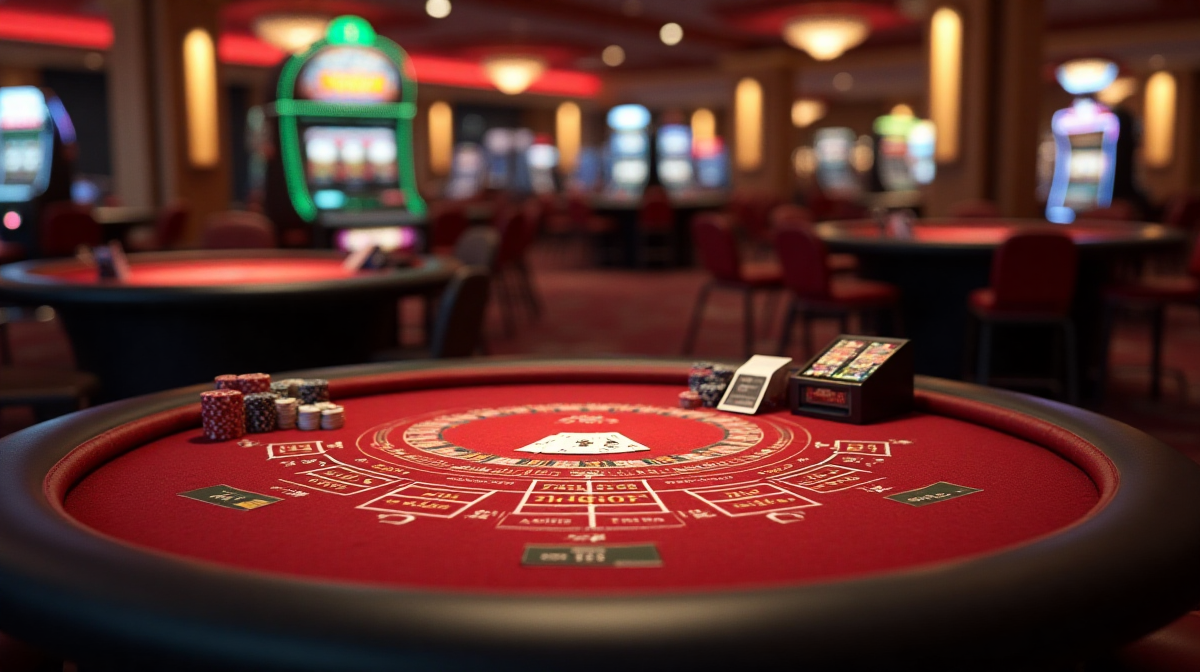Blackjack 21: 5 Strategies to Win Big Now!
What is Blackjack and Why is it Popular?
Blackjack, also known as 21, is a casino game where players compete against the dealer, aiming to get a hand value as close to 21 as possible without exceeding it. Its enduring popularity stems from its relatively simple rules combined with an element of skill. Unlike purely luck-based games, blackjack allows players to make strategic decisions that can significantly impact their odds. Many players are drawn to the thrill of the game, and even the potential to employ strategies like card counting. For those looking for a quick win, some might explore options like an i lot bet, but a solid foundation in strategy is far more reliable.
Dispelling Myths: Blackjack Isn't Just Luck
A common misconception is that blackjack is solely a game of chance. While the initial deal of the cards is random, the decisions players make after receiving their hands introduce a crucial skill component. Knowing when to hit, stand, double down, or split pairs based on your hand and the dealer’s upcard can dramatically improve your chances of winning. Successfully navigating these choices requires understanding the probabilities involved, and avoiding purely relying on gut feelings. This is where consistent strategies, even a simple i lot bet approach combined with basic strategy, can make a difference.
Understanding the House Edge & Managing Expectations
Every casino game has a house edge, which represents the casino's average profit. In blackjack, the house edge can be as low as 0.5% with optimal play using basic strategy. However, poor decision-making can quickly increase this edge. It's vital to understand the house edge and set realistic expectations. Blackjack isn't a guaranteed path to riches, but with skill and discipline, you can minimize the casino's advantage and maximize your own winning potential. Considering a modest i lot bet size initially can help with bankroll management.
Basic Strategy – Your Blackjack Foundation
What is Basic Strategy?
Basic strategy is a mathematically derived set of rules that dictate the optimal play for every possible hand combination against every dealer upcard. It’s not a foolproof system, but it consistently yields the lowest possible house edge. A basic strategy chart is a visual guide that maps out these optimal decisions. The chart typically shows player hands along the top and dealer upcards along the side, with specific actions (Hit, Stand, Double Down, Split) indicated at the intersections.
How to Read a Basic Strategy Chart
Reading a basic strategy chart is essential. The player's hand is listed on the left, and the dealer's upcard along the top. Find the intersection of your hand and the dealer’s card to determine the correct action. For example, if you have a 16 against a dealer's 10, the chart will likely advise you to hit. Memorizing the chart, or having it readily available, is a significant step towards improving your gameplay. While a quick i lot bet might seem tempting, adhering to the chart gives a much higher chance of long-term success.
Common Basic Strategy Mistakes to Avoid
Even players who know basic strategy sometimes make mistakes. Common errors include hitting on 17, not splitting Aces or 8s, and incorrectly doubling down. These seemingly small deviations can significantly increase the house edge. Consistency is key. Review the chart frequently and consciously apply its recommendations with every hand.
Free Basic Strategy Tools & Resources
Numerous free resources are available online to help you learn and practice basic strategy. Websites offer interactive charts and trainers that allow you to test your knowledge and identify areas for improvement. Utilizing these tools can accelerate your learning curve and solidify your understanding of the optimal play.
Money Management – Protecting Your Bankroll
Setting a Bankroll: How Much Should You Gamble?
Before you even sit down at the blackjack table, determine your bankroll – the total amount of money you're willing to risk. A general rule of thumb is to set aside a bankroll that can withstand a losing streak. The amount depends on your risk tolerance and playing style, but a good starting point is at least 25 times the average bet you plan to make.
Unit Sizing: Determining Your Bet Amount
Unit sizing refers to the amount you bet on each hand. A common approach is to bet 1-5% of your bankroll per hand. This helps you weather losing streaks and prevents you from depleting your funds too quickly. Avoid the temptation to increase your bet drastically after a loss, or to chase your losses with larger wagers. Think before placing even a small i lot bet.
Avoid Chasing Losses: Discipline is Key
Chasing losses is a common pitfall for gamblers. It involves increasing your bets in an attempt to recoup previous losses. This is a dangerous strategy that can quickly lead to financial ruin. If you're on a losing streak, stick to your unit sizing and avoid emotional betting. Accept losses as part of the game and don't try to win back everything at once.
When to Walk Away: Recognizing Your Limits
Knowing when to walk away is crucial for responsible gambling. Set a win goal and a loss limit before you start playing. If you reach either of these limits, stop playing. Don't get caught up in the excitement of the game and continue playing beyond your predetermined limits.
Card Counting – The Advanced Technique
What is Card Counting & How Does it Work?
Card counting is a technique used to track the ratio of high cards to low cards remaining in the deck. The High-Low system is a popular method, assigning a value of +1 to cards 2-6, 0 to cards 7-9, and -1 to cards 10-Ace. By keeping a running count, players can estimate when the deck is rich in high cards, which favors the player, and adjust their bets accordingly. Some even use this knowledge to influence a small i lot bet increase.
The Practicalities of Card Counting: Spotting Opportunities
Card counting requires concentration, mental agility, and the ability to keep a running count without being detected. Players must also be able to adjust their bets quickly when the count is favorable. This often involves increasing bets when the count is positive and decreasing them when it's negative.
Risks and Challenges of Card Counting
Casinos actively monitor players for card counting. If caught, you may be asked to leave the casino or even banned. Techniques used to detect card counters include observing betting patterns, tracking deviations from basic strategy, and using surveillance cameras.
Is Card Counting Legal?
Card counting itself is not illegal in most jurisdictions. However, casinos have the right to refuse service to anyone they suspect of counting cards. The legality of using devices to aid in card counting varies by location.
Understanding Dealer Tells and Variations
Observing Dealer Habits
While the idea of dealer tells is appealing, it's largely based on anecdotal evidence. Attempting to read a dealer’s body language or facial expressions is generally unreliable. Dealers are trained to maintain a poker face and avoid giving away any information.
Different Blackjack Variations & Adjusting Strategy
Blackjack comes in various forms, including single-deck, multi-deck, and Spanish 21. The optimal strategy varies depending on the specific rules and the number of decks used. Single-deck blackjack generally offers the lowest house edge, but it's becoming increasingly rare.
Side Bets: Are They Worth Considering?
Many casinos offer side bets in blackjack, such as Insurance or 21+3. These bets typically have a very high house edge and are generally not worth considering unless you're looking for a bit of added excitement. Even a small i lot bet has better odds.

Exploiting Casino Promotions and Online Bonuses
Maximizing Casino Comps & Loyalty Programs
Casino loyalty programs reward players with comps, such as free meals, hotel rooms, and cashback. Sign up for a loyalty card and use it every time you play. The more you play, the more rewards you'll earn.
Utilizing Online Blackjack Bonuses
Online casinos often offer bonuses to attract new players. These bonuses can include deposit matches, free spins, and cashback offers. However, be sure to read the wagering requirements carefully before accepting a bonus. Wagering requirements specify how much you need to bet before you can withdraw your winnings.
Finding the Best Online Blackjack Sites
When playing blackjack online, choose a reputable and licensed casino. Look for sites that use secure encryption technology and offer fair games. Read reviews and compare different sites before making a deposit.
Responsible Gambling & Online Security
Always gamble responsibly and within your means. Set a budget and stick to it. Take breaks regularly and avoid chasing losses. Protect your online account by using a strong password and enabling two-factor authentication.

Conclusion: Consistent Application is Key to Blackjack Success
Recap of the 5 Strategies
We’ve explored five key strategies for improving your blackjack game: mastering basic strategy, practicing sound money management, understanding card counting (and its risks), adapting to dealer variations, and leveraging casino promotions. Even a small, considered i lot bet can be part of a responsible strategy.
The Importance of Practice & Patience
Blackjack is a game of skill, but it takes time and practice to master. Don't expect to win every time. Be patient and consistent in your application of the strategies, and you'll gradually improve your results.
Final Thoughts on Winning at Blackjack
Winning at blackjack is not about luck; it’s about making informed decisions based on probability and strategy. By consistently applying these techniques, managing your bankroll responsibly, and understanding the game's nuances, you can significantly increase your chances of success. Remember, the house always has an edge, but with skill and discipline, you can narrow that edge and enjoy the thrill of the game.

